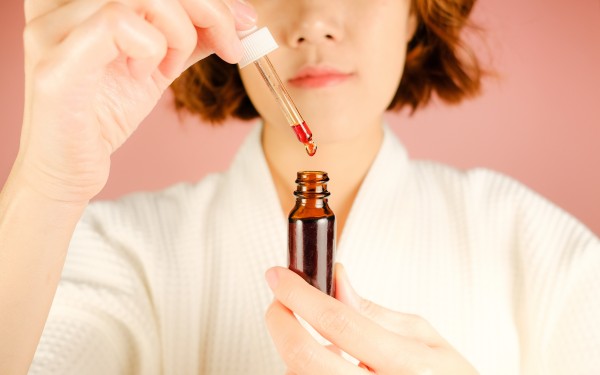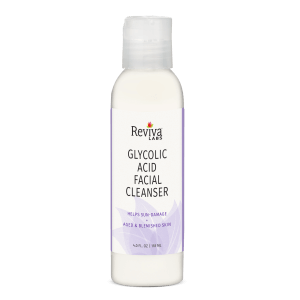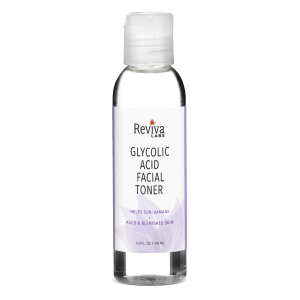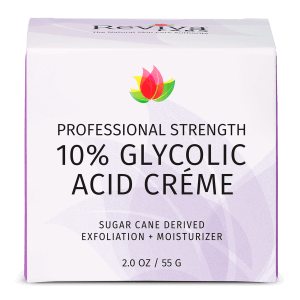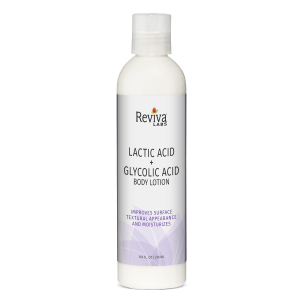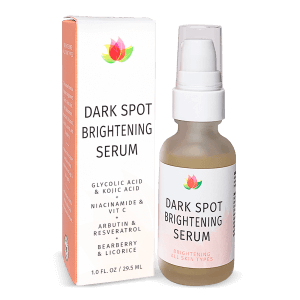Ingredients, Natural, Reviva Labs, Skin Care
Is Glycolic Acid a Good Moisturizer?
Looking to renew your skincare routine? Need a powerful ally against skin aging, hyperpigmentation, and acne? Glycolic acid, a key player in the world of alpha hydroxy acids (AHAs), has got your back. This powerhouse ingredient, derived from sugarcane, can transform your skin’s appearance, making it smoother, brighter, and more youthful.
What Is Glycolic Acid?
Glycolic acid is a water-soluble alpha hydroxy acid (AHA) derived from sugarcane. It’s a popular component in skincare products thanks to its small molecular size, which enables it to penetrate the skin effectively. As an exfoliant, glycolic acid works its magic by dissolving the bonds holding dead skin cells together, allowing your skin to renew and rejuvenate itself.
Yes, Glycolic Acid Helps to Moisturize Skin Too
But the benefits of glycolic acid extend beyond exfoliation. Glycolic acid also attracts water molecules, making it a humectant that helps hydrate your skin. It boosts collagen production, protecting your skin’s elasticity and firmness, and helps in unclogging pores and reducing acne.
Understanding How Glycolic Acid Works
Glycolic acid is unique in the AHA family due to its small molecular size. This attribute allows it to penetrate the skin and exfoliate more effectively than its AHA peers.
The magic of glycolic acid lies in its ability to speed up cell turnover. It breaks down the bonds holding skin cells together, enabling your skin to shed its old, dead cells more quickly than it would naturally.
In addition to exfoliation, glycolic acid triggers your skin to produce more collagen, the protein responsible for giving skin its firmness and elasticity. As you age, your skin produces less collagen, and exposure to the sun can further destroy it. Incorporating glycolic acid into your daily skincare routine can help protect collagen levels, helping your skin maintain its youthful bounce.

The Multifaceted Benefits of Glycolic Acid for Your Skin
Glycolic acid is a versatile skincare ingredient, offering a diverse array of benefits:
- Anti-aging: It smooths fine wrinkles and improves skin tone and texture.
- Hydration: Glycolic acid plumps the skin and prevents dryness.
- Sun damage control: It lightens dark patches caused by sun damage and protects collagen from sun exposure.
- Complexion brightening: Regular use of glycolic acid can brighten your skin.
- Exfoliation: It aids in shedding dead skin cells, preventing ingrown hairs and reducing pore size.
- Acne control: By cleaning out pores, glycolic acid helps prevent blackheads, comedones, and inflamed breakouts.
However, it’s essential to note that while glycolic acid can lighten dark patches left by acne or other wounds, it cannot make scars disappear. It may soften the look of raised and pitted scars, but a professional strength glycolic acid peel or a different scar treatment would be more effective for scar healing.
Where to Find Glycolic Acid
Glycolic acid is a common ingredient in many over the counter (OTC) skincare products. They can be found in drug stores, markets, and skin spas in the form of cleansers, masks, toners, and moisturizers. OTC glycolic acid products typically have a concentration of up to 10%.
For more potent treatments, glycolic acid is also a component in chemical peels. Light-duty glycolic acid peels up to 30% strength can be performed by an esthetician at a salon or skin spa. More potent peels of up to 70% can be administered at a dermatology clinic.
Choosing the Right Glycolic Acid Treatment
The best glycolic acid treatment for you depends on your skin type and skincare goals. OTC products with glycolic acid might be enough to brighten your skin and reduce fine lines. They could also prevent breakouts without the need for stronger professional peels.
Professional skin peels are suitable if you want to treat specific skin issues like sun damage, dark spots, deep wrinkles, or acne. While these peels can give quick results, they contain higher amounts of glycolic acid and may cause more skin irritation.
When choosing a glycolic acid treatment, the concentration of glycolic acid is one factor to consider. The product’s pH level is another crucial aspect. More acidic products will be stronger and more effective on your skin, regardless of the amount of glycolic acid they contain.
Using Glycolic Acid Safely
Glycolic acid is generally safe for your skin and brings noticeable results. However, there are a few precautions to follow when using glycolic acid.
Always wear sunscreen when using glycolic acid, as it makes your skin more sensitive to the sun. Start slowly with OTC glycolic acid products, gradually increasing frequency as your skin adjusts. For in-office peels, you’ll likely start with a lower concentration of glycolic acid, with the strength increased in subsequent sessions if your skin tolerates the treatment well.
Be cautious when using glycolic acid if you’re currently using topical retinoids or any products that rapidly exfoliate the skin. Always consult with your dermatologist before starting any glycolic acid treatment or having a peel done.
The Final Word on Glycolic Acid
Glycolic acid is a powerful skincare ingredient that comes from sugar cane. As it absorbs into the skin, it promotes cell turnover, making your skin look healthier and more radiant. It’s a common ingredient in many OTC and professional skincare products, especially anti-aging products. It supports collagen production, protects against sun damage, and helps keep pores clean.
When used wisely, glycolic acid can be a game-changer in your skincare routine, helping you achieve a brighter, smoother, and more youthful complexion. Always remember to use sunscreen, start slow, and seek professional advice when necessary. Your skin will thank you for it!
A Note of Caution
While glycolic acid products and professional peels are generally safe and known to work wonders for the skin, they may not be suitable for everyone. If you have sensitive skin, consider starting with wash-off products like cleansers. These are less likely to irritate your skin and can help build tolerance gradually.
Frequently Asked Questions
- What does glycolic acid do to your face?
Glycolic acid exfoliates the skin, speeds up cell turnover, and boosts collagen production. It helps to clear pores, smooth fine wrinkles, improve skin tone, fade dark patches and sun damage, and hydrate skin for a more youthful look.
- Is it safe to use glycolic acid every day?
Not at first. Glycolic acid can irritate your skin, and it may take a while for your skin to get used to it. Start by applying it three times a week. If your skin isn’t red or irritated, apply it four times the following week. Gradually increase the number of days you use glycolic acid as your skin begins to tolerate it.
- Does glycolic acid treat scars?
No. Despite marketing claims, there is no scientific evidence to support the use of glycolic acid to eliminate scars. Glycolic acid may help soften the appearance of scars, but it will not make them disappear.
- What should you know before using glycolic acid?
Glycolic acid can make your skin more sensitive to the sun. It is essential to wear sunscreen outdoors when using glycolic acid. Do not use topical retinoids and glycolic acid at the same time. Avoid using other products that rapidly exfoliate the skin while using glycolic acid.
Glycolic Acid is a Powerhouse Ingredient
In conclusion, glycolic acid is a powerhouse ingredient in the realm of skincare, delivering a multitude of benefits from anti-aging to acne control. However, it’s crucial to use it wisely and consult with a professional for the best results. When used correctly, glycolic acid can reveal a brighter, smoother, and more youthful complexion, making it a true game-changer in your skincare routine.





